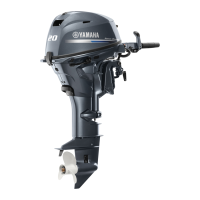Maintenance
79
When removing or installing a spark
plug, be careful not to damage the in-
sulator. A damaged insulator could
allow external sparks, which could
lead to explosion or fire.
[EWM00562]
3. Be sure to use the specified spark plug,
otherwise the engine may not operate
properly. Before fitting the spark plug,
measure the electrode gap with a wire
thickness gauge; replace it if out of spec-
ification.
4. When fitting the plug, wipe off any dirt
from the threads, and then screw it in to
the correct torque.
If a torque-wrench is not available when you
are reinstalling a spark plug, a good estimate
of the correct torque is 1/12 turn past finger-
tight. When you are installing a new spark
plug, a good estimate of the correct torque is
1/2 turn past finger-tight.
EMU37451
Checking fuel filter
Check the fuel filter periodically. If any water
or foreign matter is found in the filter, clean or
replace it. For cleaning or replacement of the
fuel filter, consult your Yamaha dealer.
EMU29045
Inspecting idle speed
EWM00452
Do not touch or remove electrical parts
when starting or during operation.
Keep hands, hair, and clothes away
from the flywheel and other rotating
parts while the engine is running.
ECM00491
This procedure must be performed while
the outboard motor is in the water. A
flushing attachment or test tank can be
used.
If the boat is not equipped with a tachometer
for the outboard motor, use a diagnostic ta-
chometer for this procedure. Results may
vary depending on whether testing is con-
ducted with the flushing attachment, in a test
tank, or with the outboard motor in the water.
1. Start the engine and allow it to warm up
Standard spark plug:
DPR6EB-9
1. Spark plug gap
2. Spark plug part number
3. Spark plug I.D. mark (NGK)
Spark plug gap:
0.8–0.9 mm (0.031–0.035 in)
Spark plug torque:
17 Nm (1.73 kgf-m, 12.5 ft-lb)
6AG-9-3D-1E0.book 79 ページ 2015年11月5日 木曜日 午前11時7分

